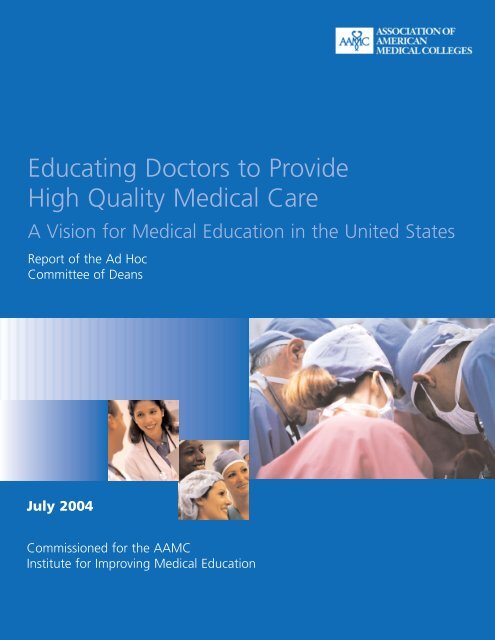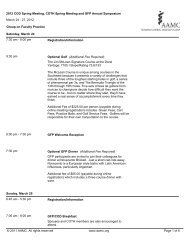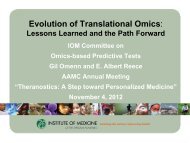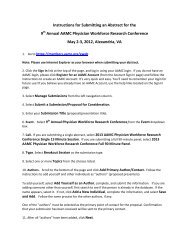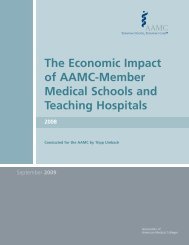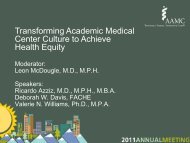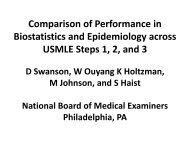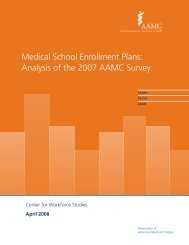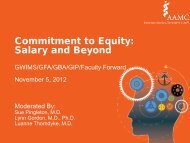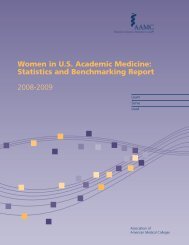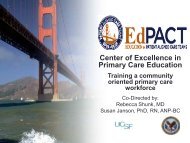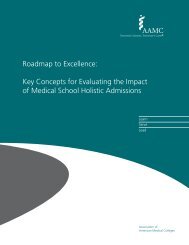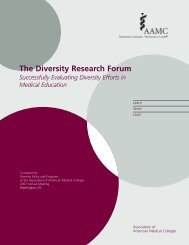Educating Doctors to Provide High Quality Medical Care - AAMC's ...
Educating Doctors to Provide High Quality Medical Care - AAMC's ...
Educating Doctors to Provide High Quality Medical Care - AAMC's ...
You also want an ePaper? Increase the reach of your titles
YUMPU automatically turns print PDFs into web optimized ePapers that Google loves.
Tomorrowís <strong>Doc<strong>to</strong>rs</strong>, Tomorrowís Cures<br />
<strong>Educating</strong> Integrating <strong>Doc<strong>to</strong>rs</strong> Education <strong>to</strong> <strong>Provide</strong><br />
<strong>High</strong> and Patient <strong>Quality</strong> <strong>Care</strong> <strong>Medical</strong> <strong>Care</strong><br />
Observations from the<br />
GME Task Force<br />
A Vision for <strong>Medical</strong> Education in the United States<br />
Report of the Ad Hoc<br />
Committee of Deans<br />
Learn<br />
Serve<br />
Lead<br />
May 2005<br />
July 2004<br />
www.aamc.org<br />
Commissioned for the AAMC<br />
Institute for Improving <strong>Medical</strong> Education<br />
Association of<br />
American <strong>Medical</strong> Colleges
For more information about this publication contact:<br />
Michael E. Whitcomb, M.D.<br />
Senior Vice President for <strong>Medical</strong> Education<br />
AAMC<br />
2450 N Street, NW<br />
Washing<strong>to</strong>n, DC 20037-1127<br />
(202) 828-0505<br />
Copyright 2004 by the Association of American <strong>Medical</strong> Colleges. All rights reserved.
AAMC 2004<br />
<strong>Educating</strong> <strong>Doc<strong>to</strong>rs</strong> <strong>to</strong> <strong>Provide</strong> <strong>High</strong> <strong>Quality</strong> <strong>Medical</strong> <strong>Care</strong><br />
A Vision for <strong>Medical</strong> Education in the United States<br />
Introduction<br />
In the fall of 2002, the Association of American<br />
<strong>Medical</strong> Colleges (AAMC) established the<br />
Institute for Improving <strong>Medical</strong> Education (IIME)<br />
<strong>to</strong> make clear the Association’s commitment <strong>to</strong><br />
respond <strong>to</strong> growing concerns about the quality<br />
of medical education in the United States. The<br />
IIME is intended <strong>to</strong> provide a highly visible<br />
vehicle within the Association for addressing<br />
those concerns. An ad hoc committee<br />
composed of ten deans was appointed <strong>to</strong> guide<br />
the initial development of the institute’s<br />
agenda. The committee was charged <strong>to</strong><br />
conduct a comprehensive review of the state of<br />
medical education and <strong>to</strong> recommend strategic<br />
directions for reform across the continuum of<br />
undergraduate, graduate, and continuing<br />
medical education.<br />
The committee held its first meeting in April<br />
2003. At that meeting, the committee<br />
members decided <strong>to</strong> begin their task by developing<br />
a vision for the country’s medical<br />
education system. They reasoned that defining<br />
both the mission and the properties of the ideal<br />
system would permit the identification of<br />
specific systemic shortcomings that must be<br />
addressed <strong>to</strong> improve the quality of medical<br />
education. Only then could appropriate<br />
strategies for making progress <strong>to</strong>ward the<br />
desired goal be recommended.<br />
During the summer and early fall, the<br />
committee met on two occasions. In preparation<br />
for those meetings, the committee<br />
members reviewed background materials<br />
developed by committee staff, which included,<br />
among other things, summaries of a series of<br />
reports issued in recent years by blue ribbon<br />
panels convened <strong>to</strong> address concerns about the<br />
state of medical education in this country. The<br />
committee also met with individuals holding<br />
leadership positions in the organizations<br />
responsible for the accreditation of undergraduate<br />
and graduate medical education<br />
programs, the accreditation of providers of<br />
continuing medical education programs, and<br />
the certification and licensure of physicians.<br />
The committee members also participated in a<br />
series of conference calls <strong>to</strong> review and discuss<br />
the content of a working document that was<br />
being drafted <strong>to</strong> solicit comments from others<br />
within the Association.<br />
In February 2004, the committee’s working<br />
document was submitted <strong>to</strong> the Administrative<br />
Boards of the constituent bodies of the<br />
Association’s governance – the Council of<br />
Deans, Council of Teaching Hospitals, Council<br />
of Academic Societies, Organization of Resident<br />
Representatives, and Organization of Student<br />
Representatives. In April 2004, the committee<br />
chair presented a summary of the working<br />
document <strong>to</strong> the deans attending the spring<br />
meeting of the Council of Deans (COD). The<br />
committee met following that presentation <strong>to</strong><br />
discuss the comments received from each of<br />
the Administrative Boards and <strong>to</strong> decide on the<br />
steps needed <strong>to</strong> finalize its report. The COD<br />
Administrative Board adopted the committee’s<br />
final report at its June 2004 meeting.<br />
Report of the Ad Hoc Committee of Deans<br />
1
AAMC 2004<br />
Committee Members<br />
Joseph B. Martin, M.D., Ph.D. (CHAIR)<br />
Dean, Harvard <strong>Medical</strong> School<br />
Harvard University<br />
Robert J. Alpern, M.D.<br />
Dean, Southwestern <strong>Medical</strong> School<br />
University of Texas Southwestern<br />
A. Lorris Betz, M.D., Ph.D.<br />
Senior Vice President for Health Sciences<br />
Dean, School of Medicine<br />
University of Utah<br />
Peter J. Deckers, M.D.<br />
Executive Vice President, Health Affairs<br />
Dean, School of Medicine<br />
University of Connecticut<br />
Steven G. Gabbe, M.D.<br />
Dean, School of Medicine<br />
Vanderbilt University<br />
E. Nigel Harris, M.D., M.S.<br />
Senior Vice President for Academic Affairs<br />
Dean, School of Medicine<br />
Morehouse University<br />
Darrell G. Kirch, M.D.<br />
CEO, Mil<strong>to</strong>n S. Hershey <strong>Medical</strong> Center<br />
Senior Vice President for Academic Affairs<br />
Dean, College of Medicine<br />
Pennsylvania State University<br />
Lois Margaret Nora, M.D., J.D.<br />
President and Dean<br />
Northeastern Ohio Universities<br />
College of Medicine<br />
Anthony J. Windebank, M.B.<br />
Dean<br />
Mayo <strong>Medical</strong> School<br />
Arthur H. Rubenstein, M.B.B.Ch.<br />
Executive Vice President<br />
Dean, School of Medicine<br />
University of Pennsylvania<br />
Committee Staff<br />
Michael E. Whitcomb, M.D.<br />
Senior Vice President for <strong>Medical</strong> Education<br />
AAMC<br />
Alexis L. Ruffin, M.S.<br />
Senior Staff Associate<br />
AAMC<br />
2<br />
Report of the Ad Hoc Committee of Deans
AAMC 2004<br />
Report of the Ad Hoc Committee of Deans<br />
The State of <strong>Medical</strong> Education<br />
Background<br />
Although it is generally believed that the quality<br />
of medical care in the United States exceeds<br />
that provided in the rest of the world, there is<br />
growing evidence indicating that the care is<br />
often less than optimal. 1 The results of a<br />
number of well-conducted studies show that<br />
doc<strong>to</strong>rs fail on occasion <strong>to</strong> use diagnostic and<br />
therapeutic approaches of proven value and <strong>to</strong><br />
communicate with patients and their families<br />
adequately, and do not always recommend<br />
health promotion and disease prevention<br />
practices of proven benefit.<br />
In 2001, the Institute of Medicine (IOM) issued<br />
a seminal report entitled Crossing the <strong>Quality</strong><br />
Chasm. A New Health System for the 21 st<br />
Century, which called attention <strong>to</strong> the need <strong>to</strong><br />
improve the quality of medical care provided in<br />
this country. 2 The report argued that <strong>to</strong><br />
improve the quality of care fundamental<br />
reforms are needed in the ways doc<strong>to</strong>rs and<br />
other health professionals are educated. The<br />
report recommended that doc<strong>to</strong>rs and other<br />
health professionals must be educated <strong>to</strong><br />
deliver patient-centered care as members of an<br />
interdisciplinary team, emphasizing evidencebased<br />
practice, quality improvement<br />
approaches, and informatics. The report recommended<br />
that a multidisciplinary summit of<br />
health professions educa<strong>to</strong>rs be organized <strong>to</strong><br />
develop strategies for aligning the education of<br />
health professionals with the agreed upon<br />
needs of the 21 st Century health care system.<br />
Particular attention was focused on the changes<br />
that might be required of the institutional<br />
sponsors of the education programs and of the<br />
various credentialing and accrediting bodies.<br />
major overhaul in health professions education,<br />
and presents in rather stark terms an<br />
assessment of the state of clinical education. 3<br />
Clinical education has not kept pace with or<br />
been responsive enough <strong>to</strong> shifting patient<br />
demographics and desires, changing health<br />
system expectations, evolving practice<br />
requirements and staffing arrangements,<br />
new information, a focus on improving<br />
quality, or new technologies.<br />
A similar theme appears in reports issued in<br />
recent years by two other blue ribbon panels –<br />
the Commonwealth Fund Task Force on<br />
Academic Heath Centers and the IOM<br />
Committee on the Roles of Academic Health<br />
Centers in the 21 st Century. 4, 5 In their reports,<br />
both panels expressed serious concerns about<br />
the state of medical education in this country<br />
and acknowledged that reforms are needed in<br />
the clinical education of doc<strong>to</strong>rs if the quality of<br />
care provided is <strong>to</strong> be improved. By linking the<br />
attainment of improvements in medical care<br />
quality <strong>to</strong> reforms in medical education, the<br />
reports focus attention most directly on the<br />
state of graduate medical education (GME),<br />
because it is during residency training that<br />
doc<strong>to</strong>rs learn how <strong>to</strong> perform the complex<br />
integrative tasks that are required <strong>to</strong> provide<br />
high quality care. Of note, both reports call on<br />
academic medical centers <strong>to</strong> take the lead in<br />
ensuring that the reforms needed in GME occur.<br />
In response, the IOM convened a summit of<br />
health professions educa<strong>to</strong>rs <strong>to</strong> determine what<br />
needed <strong>to</strong> be done <strong>to</strong> improve the quality of<br />
health professions education. The report from<br />
the summit begins by restating the need for a<br />
Report of the Ad Hoc Committee of Deans<br />
3
AAMC 2004<br />
Issues of Concern<br />
The high level concerns expressed in the reports<br />
cited previously are that the design, content, and<br />
conduct of undergraduate and graduate medical<br />
education programs have not kept pace with:<br />
advances occurring in the biomedical sciences; the<br />
introduction of new approaches for the diagnosis<br />
and management of disease; changes in the<br />
organization, financing, and delivery of health<br />
care services; and changes in society’s expectations<br />
of medicine. But <strong>to</strong> develop strategies for<br />
addressing those general concerns, specific shortcomings<br />
in the ways doc<strong>to</strong>rs are being educated –<br />
shortcomings that exist across the continuum of<br />
undergraduate, graduate, and continuing medical<br />
education – must be acknowledged.<br />
For example, despite growing concerns about the<br />
quality of the clinical education of medical<br />
students, few medical schools have implemented<br />
fundamental changes in their clinical curricula. 6<br />
Most schools continue <strong>to</strong> require clerkships in the<br />
same set of core clinical disciplines that were<br />
viewed as critical in preparing doc<strong>to</strong>rs for general<br />
practice in the 1950s, even though clinical experiences<br />
in additional disciplines would be highly<br />
relevant for students preparing for careers in<br />
modern medicine. 7 Moreover, the design and<br />
conduct of those traditional clerkships remain<br />
largely unchanged in most schools despite<br />
widespread concern about the relevance and<br />
value of many of the experiences students have<br />
during their clerkship rotations. And finally, the<br />
attention being paid <strong>to</strong> the teaching and<br />
assessment of clinical skills is generally considered<br />
<strong>to</strong> be inadequate, at least in part because of the<br />
reluctance of some clinical faculty <strong>to</strong> commit the<br />
time <strong>to</strong> teach these skills <strong>to</strong> students. 8<br />
<strong>Medical</strong> schools are mindful of these shortcomings<br />
and have begun <strong>to</strong> address them. In the<br />
past decade, medical schools have made<br />
profound changes in the organization and<br />
structure of their curricula and in the pedagogical<br />
strategies they employ <strong>to</strong> enhance their students’<br />
learning. 9,10 Although the changes have been<br />
limited largely <strong>to</strong> the first two years of the<br />
curriculum in the majority of schools, some<br />
reform efforts are now under way <strong>to</strong> improve the<br />
clinical education students receive during the last<br />
two years of the curriculum. As an example, The<br />
New York Academy of Medicine, in collaboration<br />
with the AAMC and with funds provided by the<br />
Josiah Macy, Jr. Foundation and the Arthur Vining<br />
Davis Foundation, has recently awarded grants <strong>to</strong><br />
six medical schools <strong>to</strong> assist them in their efforts<br />
<strong>to</strong> introduce fundamental innovations in<strong>to</strong> the<br />
teaching of clinical medicine.<br />
Although the quality of the education received by<br />
medical students is clearly important, it is during<br />
residency training that physicians acquire the<br />
detailed knowledge, the special skills, and the<br />
professional attitudes needed <strong>to</strong> provide high<br />
quality care in medical practice. Especially<br />
worrisome, therefore, is the mounting evidence<br />
that many residency programs are not preparing<br />
resident physicians adequately for their future<br />
responsibilities. 12,13 One of the explanations for<br />
this is that the design and conduct of residency<br />
programs have not been based on a clear, databased<br />
understanding of the kinds of patients<br />
residents will care for most often after they enter<br />
practice and the scope of practice that they will<br />
be expected <strong>to</strong> provide. Instead, residency<br />
programs are overly influenced by the tradition<br />
and culture of specific clinical disciplines and by<br />
the patient care service needs of teaching<br />
hospitals and their clinical faculties. Of particular<br />
note, the education of resident physicians<br />
continues <strong>to</strong> be based largely in the inpatient<br />
services of major teaching hospitals where<br />
residents spend the majority of their time involved<br />
in the care of patients with acute, episodic<br />
illnesses. Those experiences can not adequately<br />
prepare residents, at least in several of the<br />
specialties, <strong>to</strong> provide high quality care <strong>to</strong> the<br />
kinds of patients they are most likely <strong>to</strong> encounter<br />
on entering practice, or <strong>to</strong> provide that care in<br />
non-hospital settings.<br />
Having recognized the importance of these issues,<br />
several clinical disciplines have undertaken<br />
projects designed <strong>to</strong> enhance the design and<br />
conduct of their GME programs. For example, a<br />
report describing the results of the Future of<br />
Family Practice Project – a project conducted over<br />
a two and one-half year period by the leadership<br />
of the family practice community – was issued<br />
4<br />
Report of the Ad Hoc Committee of Deans
AAMC 2004<br />
this past spring. 14 The report notes that changes<br />
are needed in the design and conduct of family<br />
practice residency programs <strong>to</strong> better prepare<br />
program graduates for practice, and it recommends<br />
that programs introduce innovations that<br />
will accomplish that purpose. Similarly, a blue<br />
ribbon committee of the American College of<br />
Surgeons has issued a report calling for changes<br />
in the design and conduct of surgical GME<br />
programs. 15 And a committee of the Society for<br />
General Internal Medicine has issued a report that<br />
is highly critical of training in general internal<br />
medicine and calls for substantive reforms in<br />
internal medicine residency programs. 16 These<br />
reports reinforce the generally held view that<br />
fundamental changes are needed in GME.<br />
To this end, the Accreditation Council for<br />
Graduate <strong>Medical</strong> Education embarked several<br />
years ago on a project designed <strong>to</strong> shift the<br />
orientation of GME accreditation from its heavy<br />
emphasis on process measures <strong>to</strong> an increasing<br />
focus on educational outcomes. 17 In the future,<br />
programs will no longer be accredited solely by<br />
meeting requirements focused on the design and<br />
conduct of the program. Instead, program<br />
direc<strong>to</strong>rs will have <strong>to</strong> document <strong>to</strong> the satisfaction<br />
of the accrediting body that their<br />
residents have met predetermined performance<br />
standards in six domains of learning and practice<br />
(so called core competencies). In other words,<br />
they will have <strong>to</strong> demonstrate that residents<br />
completing their program have achieved learning<br />
objectives that are believed <strong>to</strong> correlate with the<br />
ability <strong>to</strong> provide clinically competent care.<br />
But focusing solely on changes needed in undergraduate<br />
and graduate medical education<br />
programs – the focus of virtually all previous<br />
medical education reform efforts – will not be<br />
adequate <strong>to</strong> meet contemporary challenges.<br />
Given the growing complexity of medical care<br />
and the rapidity with which changes are<br />
occurring in accepted standards of practice, the<br />
quality of care provided by doc<strong>to</strong>rs over the<br />
course of their professional careers will be determined<br />
increasingly by the kinds of the continuing<br />
medical education activities they pursue. 18 At<br />
present, the majority of continuing medical<br />
education activities offered <strong>to</strong> physicians employ<br />
learning methods (primarily lecture-based formats)<br />
that have been shown not <strong>to</strong> have a positive<br />
effect on the quality of care physicians provide <strong>to</strong><br />
their patients. Moreover, professional organizations,<br />
certifying bodies, and licensing authorities<br />
have policies in place that encourage and reward<br />
physicians for participating in those programs.<br />
The literature on effective CME suggests strongly<br />
that self-directed learning exercises are the most<br />
successful in changing physicians’ practice<br />
behaviors. To be effective, the content, learning<br />
methods, and learning resources must be selected<br />
specifically for the purpose of maintaining or<br />
improving the knowledge, skills, and attitudes a<br />
given physician needs on a regular basis in his or<br />
her practice. 19 The literature also suggests that<br />
continuing medical education learning exercises<br />
should incorporate interactive learning formats,<br />
and include practice enabling and reinforcing<br />
strategies; and that <strong>to</strong> the degree possible, the<br />
learning experiences should be accessible within<br />
physicians’ practice or work settings.<br />
Fortunately, many of the organizations involved<br />
in developing and implementing the policies that<br />
affect the CME enterprise have begun efforts <strong>to</strong><br />
address some of the clearly defined shortcomings<br />
in the ways CME is conducted. The<br />
American <strong>Medical</strong> Association, which grants the<br />
credits that physicians receive for participating in<br />
accredited CME activities, is engaged in several<br />
pilot projects designed <strong>to</strong> evaluate how credit<br />
might be given for participating in non-traditional<br />
CME activities. In addition, the<br />
Accreditation Council for Continuing <strong>Medical</strong><br />
Education (ACCME) is exploring ways that its<br />
accreditation procedures might accelerate the<br />
adoption of CME activities that demonstrably<br />
change physicians’ practice behaviors. The<br />
ACCME and AAMC are now collaborating on a<br />
project designed <strong>to</strong> gain a better understanding<br />
of how this might be accomplished.<br />
The efforts currently under way <strong>to</strong> improve CME<br />
are intended <strong>to</strong> ensure that physicians remain<br />
clinically competent over the course of their<br />
careers. The American Board of <strong>Medical</strong><br />
Report of the Ad Hoc Committee of Deans<br />
5
AAMC 2004<br />
Specialties has launched an important initiative in<br />
this regard by obligating each of its member<br />
boards <strong>to</strong> develop and implement a Maintenance<br />
of Certification program.<br />
These programs will require board certified physicians<br />
who wish <strong>to</strong> maintain their credentials as<br />
specialists <strong>to</strong> periodically demonstrate that they<br />
possess the knowledge, skills, and attitudes<br />
deemed necessary by the board, and <strong>to</strong><br />
document that their practice performance is<br />
consistent with high professional standards. 20<br />
Obstacles <strong>to</strong> Reform<br />
The shortcomings that exist in the ways<br />
doc<strong>to</strong>rs are educated must be remedied if the<br />
quality of the medical care provided in this<br />
country is <strong>to</strong> improve. Achieving this goal<br />
presents a major challenge, since many of the<br />
shortcomings that must be addressed are<br />
deeply entrenched in the tradition and culture<br />
of the institutions and organizations that<br />
compose the medical education system. As<br />
illustrated by several of the examples cited<br />
above, major associations, specialty societies,<br />
specialty boards, accrediting bodies, and<br />
licensing authorities will have <strong>to</strong> reach<br />
agreement on approaches needed <strong>to</strong> remedy<br />
these shortcomings. The magnitude of this<br />
challenge is emphasized in a report issued<br />
recently by The Blue Ridge Academic Health<br />
Group – a group of individuals holding<br />
leadership positions in academic medicine –<br />
which highlights the large number of organizations<br />
that influence, in one way or another, the<br />
conduct of medical education in this country. 21<br />
Their report points out that the institutions and<br />
organizations within the system operate largely<br />
independently of each other in adopting<br />
policies and positions on issues affecting<br />
medical education. Each is free <strong>to</strong> adopt and<br />
implement policies and positions that affect<br />
medical education without concern for their<br />
impact on the functioning of the system as a<br />
whole, and each guards its right <strong>to</strong> act in<br />
accord with the interests of its particular<br />
constituents, often without seeming <strong>to</strong> take<br />
in<strong>to</strong> account the impact of its actions.<br />
The quality of medical education will improve only<br />
if each of the components of the country’s medical<br />
education system – medical schools and teaching<br />
hospitals, accrediting bodies, certifying bodies,<br />
licensing authorities, and professional societies and<br />
organizations – is committed <strong>to</strong> making progress<br />
<strong>to</strong>ward achieving an ideal medical education<br />
system. The goal is the achievement of a system<br />
that provides excellent medical education<br />
throughout a physician’s career. The lack of a<br />
mechanism for coordinating policies and positions<br />
across institutions and organizations is a major<br />
obstacle <strong>to</strong> achieving that goal. Creating such a<br />
mechanism is one of the greatest challenges facing<br />
those in leadership positions in the institutions and<br />
organizations composing the system.<br />
The complex and often opaque means presently<br />
employed for financing medical education also<br />
present obstacles <strong>to</strong> making some of the changes<br />
needed <strong>to</strong> improve the education process. In the<br />
case of undergraduate medical education, lack of<br />
agreement exists even about the true costs of<br />
educating medical students, let alone about the<br />
principles that should govern how those costs are<br />
<strong>to</strong> be financed. The current method for financing<br />
the costs of residents’ education is tightly coupled<br />
<strong>to</strong> hospital generated, patient-care revenues and<br />
concerns about the adequacy and allocation of<br />
those revenues impede efforts <strong>to</strong> reform residency<br />
training in many disciplines. And finally, the heavy<br />
dependence on industry sponsorship <strong>to</strong> defray the<br />
costs of continuing medical education hampers<br />
efforts <strong>to</strong> make fundamental changes in the third<br />
segment of the medical education continuum.<br />
6<br />
Report of the Ad Hoc Committee of Deans
AAMC 2004<br />
The Ideal <strong>Medical</strong> Education System<br />
The Mission<br />
The mission of the medical education system of<br />
the United States is <strong>to</strong> serve society by educating<br />
and training a diverse medical workforce capable<br />
of meeting the country’s need for physicians<br />
engaged in the practice of clinical medicine,<br />
public health practice, biomedical and health<br />
services research, medical education, and<br />
medical administration; and for physicians who<br />
can contribute <strong>to</strong> fields such as ethics, law,<br />
public policy, business, and journalism. The<br />
system can meet its unique responsibility <strong>to</strong><br />
educate and train highly competent medical<br />
practitioners only by ensuring that they acquire<br />
and possess throughout their careers the<br />
knowledge, skills, attitudes, and values needed<br />
for medical practice as members of an interdisciplinary<br />
health care team, and the ability <strong>to</strong><br />
perform the complex, integrative tasks required<br />
<strong>to</strong> provide high quality care <strong>to</strong> the patients who<br />
seek their help.<br />
Properties of the System<br />
To create a diverse medical workforce capable<br />
of meeting society’s needs, the system will:<br />
be effective, efficient, and affordable<br />
attract and successfully educate a diverse<br />
group of learners<br />
support the health and well being of learners<br />
cultivate men<strong>to</strong>ring relationships for learners<br />
at each stage of their careers<br />
encourage and support learners who have<br />
diverse career goals<br />
provide opportunities for learners <strong>to</strong> engage<br />
in effective learning experiences throughout<br />
their careers<br />
provide opportunities for learners <strong>to</strong> shift<br />
the focus of their professional goals during<br />
the course of their careers<br />
To produce practitioners of clinical medicine<br />
who will provide high quality care <strong>to</strong> the<br />
patients that seek their help, the system will<br />
promote:<br />
a humanistic approach <strong>to</strong> medicine<br />
an appreciation of the importance of the<br />
biological and population sciences for the<br />
advancement of medicine<br />
a patient centered approach <strong>to</strong> medical care<br />
an appreciation of the importance of fundamental<br />
research for the advancement of<br />
medical practice<br />
an understanding of the organization,<br />
financing, and delivery of health care in the<br />
United States<br />
a global perspective on contemporary health<br />
issues<br />
the system will ensure that doc<strong>to</strong>rs are able <strong>to</strong>:<br />
provide culturally sensitive and appropriate<br />
care<br />
listen and communicate effectively<br />
weigh quality of life issues appropriately<br />
when making patient care decisions<br />
access and use available evidence effectively<br />
and efficiently when making patient care<br />
decisions<br />
provide care in the face of uncertainty and<br />
doubt<br />
use resources efficiently and effectively in<br />
providing patient care<br />
use technologies appropriately in providing<br />
patient care<br />
participate effectively in multidisciplinary and<br />
team approaches <strong>to</strong> patient care<br />
contribute <strong>to</strong> eliminating medical errors and<br />
improving the quality of health care<br />
balance individual and population health<br />
needs when making patient care decisions<br />
Report of the Ad Hoc Committee of Deans<br />
7
AAMC 2004<br />
To ensure that those learning objectives are<br />
achieved, the system will:<br />
develop and support effective teachers of<br />
medicine<br />
employ educational strategies of demonstrated<br />
effectiveness<br />
employ educational technologies that<br />
enhance learning<br />
promote the acquisition of skills necessary<br />
for self-directed learning<br />
provide developmentally appropriate opportunities<br />
for learners <strong>to</strong> acquire the attributes<br />
– knowledge, skills, attitudes, and values –<br />
they will need <strong>to</strong> meet their professional<br />
responsibilities<br />
provide learning experiences that promote a<br />
thorough understanding of the biomedical<br />
sciences and the relevance of those sciences<br />
<strong>to</strong> the practice of clinical medicine<br />
provide clinical education experiences<br />
primarily in settings where learners will<br />
encounter the kinds of patients they are<br />
most likely <strong>to</strong> care for after entering practice<br />
To ensure that learners have acquired and<br />
possess throughout their careers the<br />
knowledge, skills, attitudes, and values needed<br />
<strong>to</strong> be a competent physician and the ability <strong>to</strong><br />
perform the complex, integrative tasks required<br />
<strong>to</strong> provide high quality medical care <strong>to</strong> their<br />
patients, the system will:<br />
base graduation from undergraduate and<br />
graduate medical education programs on<br />
learners’ ability <strong>to</strong> demonstrate that they<br />
have acquired the learning objectives set<br />
forth by their programs<br />
base accreditation of undergraduate and<br />
graduate medical education programs on the<br />
programs’ documentation that learners have<br />
acquired in a developmentally appropriate<br />
manner the learning objectives set forth<br />
conduct rigorous assessment of learners’<br />
abilities throughout the course of their<br />
careers <strong>to</strong> assist them in improving their<br />
performance (formative assessment) and <strong>to</strong><br />
ensure that they have achieved the level of<br />
performance required <strong>to</strong> advance professionally<br />
(summative assessment)<br />
base licensure and specialty certification on<br />
physicians’ demonstrated ability <strong>to</strong> provide<br />
high quality medical care <strong>to</strong> patients<br />
8<br />
Report of the Ad Hoc Committee of Deans
AAMC 2004<br />
Strategies for Affecting Reform<br />
All of the shortcomings of the current system<br />
cannot be addressed immediately. But there are<br />
specific actions that can be taken in the near<br />
term <strong>to</strong> improve the quality of medical education<br />
in this country. Following are examples of the<br />
kinds of actions that should be undertaken.<br />
To promote a patient-centered approach <strong>to</strong><br />
medical care:<br />
<strong>Medical</strong> schools should present early in the<br />
curriculum a patient-centered clinical<br />
experience that will imprint on entering<br />
students the importance of viewing a<br />
patient as a person, a member of a family,<br />
and a member of a community.<br />
<strong>Medical</strong> schools and residency programs<br />
should provide clinical learning experiences<br />
of an interdisciplinary nature for the purpose<br />
of preparing future physicians <strong>to</strong> function<br />
effectively as members of a care team.<br />
To ensure that doc<strong>to</strong>rs are capable of providing<br />
high quality medical care:<br />
<strong>Medical</strong> schools and residency programs<br />
should establish rigorous formative and<br />
summative assessment programs <strong>to</strong> ensure<br />
that students and residents are acquiring the<br />
knowledge, skills, attitudes, and values<br />
deemed necessary at their stage of learning,<br />
and that they are able <strong>to</strong> perform in a developmentally<br />
appropriate manner, the<br />
complex, integrative tasks required <strong>to</strong><br />
provide high quality patient care.<br />
Accrediting bodies should ensure that<br />
undergraduate and graduate medical<br />
education programs document that learners<br />
have acquired the learning objectives –<br />
knowledge, skills, attitudes, and values –<br />
established by the programs.<br />
Specialty boards should grant specialty certification<br />
(initial certification and recertification)<br />
only <strong>to</strong> those who successfully demonstrate<br />
clinical competence in their specialty of practice.<br />
Licensing authorities should grant licensure<br />
(initial licensure and re-licensure) only <strong>to</strong><br />
physicians who have completed an<br />
accredited residency program and regularly<br />
demonstrate clinical competence in the<br />
practice of their specialty.<br />
Licensing authorities, specialty societies, and<br />
other professional organizations should<br />
revise their policies affecting continuing<br />
medical education <strong>to</strong> ensure that physicians<br />
engage throughout their careers in learning<br />
activities that are effective in improving<br />
their practice behaviors.<br />
To ensure that medical students understand<br />
the various career options available:<br />
<br />
<br />
<strong>Medical</strong> schools should provide students<br />
with appropriate experiences <strong>to</strong> acquaint<br />
them with the various career options<br />
available <strong>to</strong> physicians.<br />
<strong>Medical</strong> schools should offer a variety of<br />
joint degree and research training<br />
programs, and should be flexible in tailoring<br />
programs that allow students, residents,<br />
and practitioners <strong>to</strong> acquire the education<br />
needed <strong>to</strong> pursue specific career goals.<br />
To improve the efficiency of the educational<br />
process:<br />
<strong>Medical</strong> schools should explore the possibility<br />
of integrating in<strong>to</strong> undergraduate,<br />
pre-medicine programs some of the<br />
course work required in the biological<br />
sciences, bioethics, the medical humanities,<br />
informatics, communication skills,<br />
and health systems.<br />
<br />
<strong>Medical</strong> schools, residency programs, and<br />
accrediting bodies should explore the<br />
possibility of providing opportunities for<br />
residency requirements <strong>to</strong> be integrated<br />
in<strong>to</strong> the medical school curriculum.<br />
Report of the Ad Hoc Committee of Deans<br />
9
AAMC 2004<br />
Accrediting bodies should regularly review<br />
existing program requirements <strong>to</strong> ensure that<br />
they truly reflect the education and training<br />
experiences needed for preparation for<br />
practice.<br />
Accrediting bodies should facilitate<br />
integration of the clinical education of<br />
learners across the undergraduate and<br />
graduate medical education continuum by<br />
coordinating the adoption of relevant<br />
accreditation policies.<br />
<strong>Medical</strong> schools and teaching hospitals that<br />
sponsor graduate medical education<br />
programs should establish and empower<br />
educational councils composed of the institutional<br />
officials responsible for undergraduate<br />
and graduate medical education <strong>to</strong><br />
ensure optimal integration of the clinical<br />
education of learners.<br />
To improve the effectiveness of the educational<br />
process:<br />
<strong>Medical</strong> schools should develop and support a<br />
cadre of teaching faculty whose main responsibility<br />
is the education of students as they<br />
progress through the educational program.<br />
<strong>Medical</strong> schools should require faculty<br />
members and residents who have regular<br />
contact with students <strong>to</strong> complete periodically<br />
a program orienting them <strong>to</strong> the goals<br />
and objectives of the educational program as<br />
a whole, and those of the specific student<br />
learning experiences in which they participate.<br />
<strong>Medical</strong> schools should develop programs<br />
that ensure that students are exposed during<br />
their clinical education experiences <strong>to</strong><br />
members of the clinical faculty who are<br />
recognized <strong>to</strong> be outstanding clinicians and<br />
clinician teachers.<br />
<strong>Medical</strong> schools and teaching hospitals<br />
should share learning resources (e.g.,<br />
simulation labora<strong>to</strong>ries, standardized patient<br />
programs, information technology applications,<br />
etc.) <strong>to</strong> ensure that learners at each<br />
stage of their education receive the highest<br />
quality educational experience.<br />
<strong>Medical</strong> schools and teaching hospitals<br />
should develop and conduct the kinds of<br />
continuing medical education programs that<br />
have been demonstrated <strong>to</strong> be effective in<br />
improving physicians’ practice behaviors.<br />
10<br />
Report of the Ad Hoc Committee of Deans
AAMC 2004<br />
AAMC Action Agenda<br />
In its 1996 strategic plan, the AAMC declared<br />
its intent <strong>to</strong> be the champion of medical<br />
education. It strives <strong>to</strong> fulfill this commitment<br />
by stimulating changes in medical education<br />
that will lead <strong>to</strong> a better alignment of educational<br />
content and goals with evolving societal<br />
needs, practice patterns, and scientific developments.<br />
22 Thus, the AAMC is positioned <strong>to</strong> play<br />
a leadership role in guiding the enterprise<br />
<strong>to</strong>ward the ideal system envisioned by the<br />
committee – one that provides truly excellent<br />
medical education.<br />
To pursue this goal, the AAMC should strive <strong>to</strong><br />
achieve two major strategic objectives:<br />
Effect major changes needed in the institutional<br />
and organizational policies now<br />
governing the medical education system <strong>to</strong><br />
achieve the ideal system envisioned by the<br />
committee.<br />
To achieve these objectives, the AAMC should<br />
convene a series of task forces <strong>to</strong> address issues<br />
that affect directly the design and conduct of<br />
the educational programs conducted by<br />
medical schools and teaching hospitals, the<br />
certification and licensure of practitioners<br />
throughout their professional careers, the<br />
financing of medical education, and the<br />
fragmentation of policymaking within the<br />
medical education system. The task forces<br />
should be organized as collaborative ventures<br />
that involve the leadership of all of the organizations<br />
that have an effect on the relevant<br />
issues. In addition, the AAMC should collaborate<br />
with foundations and other funding<br />
sources <strong>to</strong> establish grant programs that can<br />
support the efforts of institutions and organizations<br />
<strong>to</strong> develop and implement innovations in<br />
medical education.<br />
Catalyze the educational innovations needed<br />
across the entire educational continuum <strong>to</strong><br />
achieve the educational objectives outlined<br />
in this report.<br />
Report of the Ad Hoc Committee of Deans<br />
11
AAMC 2004<br />
Selected References<br />
1. McGlynn EA, Asch SM, Adams J, et al. The<br />
quality of health care delivered <strong>to</strong> adults in<br />
the United States. N Engl J Med 2003; 348:<br />
2635-45.<br />
2. Institute of Medicine. Crossing the <strong>Quality</strong><br />
Chasm. A New Health System for the 21 st<br />
Century. Washing<strong>to</strong>n, D.C.: National<br />
Academy Press, 2001.<br />
3. Institute of Medicine. Health Professions<br />
Education. A Bridge <strong>to</strong> <strong>Quality</strong>.<br />
Washing<strong>to</strong>n, D.C.: National Academy Press,<br />
2003.<br />
4. Training Tomorrow’s <strong>Doc<strong>to</strong>rs</strong>. The <strong>Medical</strong><br />
Education Mission of Academic Health<br />
Centers. New York, N.Y.: The<br />
Commonwealth Fund, 2002.<br />
5. Institute of Medicine. Academic Health<br />
Centers: Leading Change in the 21 st<br />
Century. Washing<strong>to</strong>n, D.C.: National<br />
Academy Press, 2003.<br />
6. The AAMC Project on the Clinical Education<br />
of <strong>Medical</strong> Students. Washing<strong>to</strong>n, D.C.:<br />
Association of American <strong>Medical</strong> Colleges,<br />
2001.<br />
7. Curriculum Direc<strong>to</strong>ry. Washing<strong>to</strong>n, D.C.:<br />
Association of American <strong>Medical</strong> Colleges,<br />
2004<br />
8. Teaching Clinical Skills. Washing<strong>to</strong>n, D.C.:<br />
Association of American <strong>Medical</strong> Colleges,<br />
2004.<br />
9. The Education of <strong>Medical</strong> Students: Ten<br />
S<strong>to</strong>ries of Curriculum Change. New York,<br />
N.Y.: Milbank Memorial Fund, 2000.<br />
10. A Snapshot of <strong>Medical</strong> Students’ Education<br />
at the Beginning of the 21st Century;<br />
Reports from 130 Schools. Academic<br />
Medicine 2000; 75 Supplement: 1-460.<br />
11. <strong>Medical</strong> School Tuition and Young Physician<br />
Indebtedness. Washing<strong>to</strong>n, D.C.:<br />
Association of American <strong>Medical</strong> Colleges,<br />
2004.<br />
12. Blumenthal D, Gokhale M, Campbell EG,<br />
Weissman JS. Preparedness for clinical practice.<br />
Reports of graduating residents at academic<br />
health centers. JAMA 2001; 286: 1027-34.<br />
13. Wiest FC, Ferris TG, Gokhale M, et al.<br />
Preparedness of internal medicine and<br />
family practice residents for treating<br />
common conditions. JAMA 2002; 288:<br />
2609-14.<br />
14. Bucholtz JR, Matheny SC, Pugno PA, et.<br />
Task Force report 2. Report of the Task<br />
Force on <strong>Medical</strong> Education. Ann Fam Med<br />
2004; 2 Supplement: 51-64.<br />
15. ASA Blue Ribbon Committee on Surgical<br />
Education. Chicago, Ill.: American College<br />
of Surgeons, 2004.<br />
16. The Future of General Internal Medicine.<br />
Report and Recommendations from the<br />
Society of General Internal Medicine (SGIM)<br />
Task Force on the Domain of General<br />
Internal Medicine. J Gen Intern Med 2004;<br />
19: 69-77.<br />
17. Outcome Project. Chicago, Ill.: Accreditation<br />
Council for Graduate <strong>Medical</strong> Education,<br />
1999.<br />
18. Newhouse JP. Why is there a quality chasm?<br />
Health Affairs 2002; 21: 13-25.<br />
19. Mazmanian PE, Davis DA. Continuing<br />
medical education and the physician as a<br />
learner. Guide <strong>to</strong> evidence. JAMA 2002;<br />
288: 1057-60.<br />
20. Maintenance of Certification. Evans<strong>to</strong>n, Ill.:<br />
American Board of <strong>Medical</strong> Specialties, 2002.<br />
21. The Blue Ridge Academic Health Group.<br />
Reforming <strong>Medical</strong> Education: Urgent<br />
Priority for Academic Health Center in the<br />
New Century. Atlanta, Ga.: The Robert W.<br />
Woodruff Health Sciences Center, 2003.<br />
22. Taking Charge of the Future. The Strategic<br />
Plan for the Association of American <strong>Medical</strong><br />
Colleges. Washing<strong>to</strong>n, D.C.: Association of<br />
American <strong>Medical</strong> Colleges, 1996.<br />
12<br />
Report of the Ad Hoc Committee of Deans


